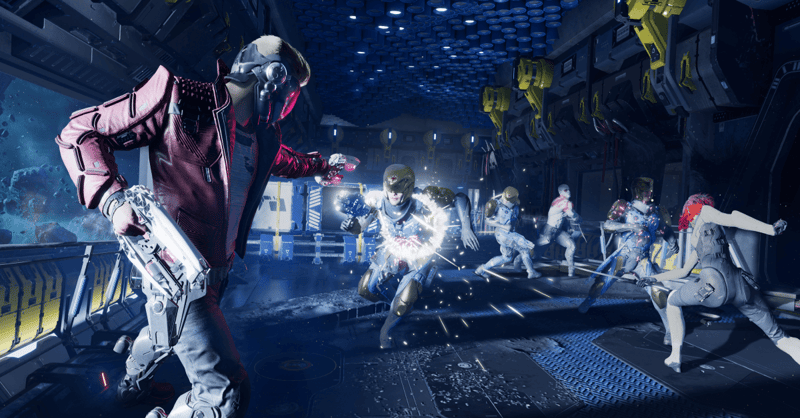Learn more about how the accessibility team at Marvel's Guardians of the Galaxy approached audio features to empower all players.
In my personal experience, accessibility remains a vague topic when making games. As a game developer, you don’t really know what should be done in terms of features and options, nor when is the best time to bring these ideas to life. Of course, one might say ‘As much as possible and as soon as possible’, and while that’s true, it remains abstract. Things are clearly getting better, but we’re not quite there yet in terms of industry standards.
My experience working on Marvel’s Guardians of the Galaxy has taught me a lot regarding the subject, and I want to shed some light on how we approached this topic, as well as offer a deeper look at the audio-related accessibility features I’ve worked on during the production.

When I joined the sound team in late 2018, there were already ongoing talks surrounding accessibility-related ambitions and goals. Thanks to the presence of a good bunch of people championing these discussions, accessibility never felt like an afterthought.
Even then, the subject was nebulous. I can’t speak for everyone involved, but from my perspective, there was a lot of talk and very little structure. Then came the creation of the accessibility team in 2020.
Work had thankfully already been underway for a while regarding features and tech, but this marked the start of something great. The mere existence of an accessibility team meant that discussions would become more frequent, and that accessibility was now officially part of our design philosophy.
For me, this also meant that there was now more support regarding fleshing out ideas. Champions existed before, but we all came together thanks to this new initiative. Working on audio-related accessibility features didn’t feel like I was blindly trying to get there. Instead, inter-departmental discussions started to commonly take place, and things really started shaping up.
Once we made an in-depth list that assessed what was desired, how achievable these ideas were and who would be responsible for seeing them through, the party really started.
"Offering more options to users means they can tweak the experience to best suit their needs, thus making gaming more accessible."

Thankfully, a large chunk of the work was already done by this stage, as we’ve already had worked on our ‘Advanced Audio Settings’ menu back in 2019. We wanted to offer the most customization possible to our players, so we tossed in sliders and buttons to best serve everyone’s individual needs. Mixing adjustments, speaker configurations and dynamic range selections were in!
These may not look like accessibility-related elements, but I believe that offering more options to users means they can tweak the experience to best suit their needs, thus making gaming more accessible.
1. Focus Mix
After this, I started toying with more experimental features. First one that came up was the ‘Focus Mix’. This feature initially aimed to be a way to lighten the cognitive load of the game, but then also became a great way to enjoy the game when playing it at very low volume. How does it work? It’s simple. Think of it as a mix sitting on top of the main audio mix of the game. When enabled, it simply reduces the playback volume of non-critical elements from the soundscape. That way, voices and musical elements get more room to breathe.
2. Loud Volume slider
Next up was the ‘Loud Volume’ slider. Again, very straightforward concept. This slider allows users to lower the playback volume of the loudest sounds independently from the dynamic range settings defined by the users. In other words, this works as a limiter placed on our master audio bus. This slider simply drives the gain reduction via automated ratio and threshold curves. For best results, it’s strongly suggested to use this with a narrow audio dynamic range to better guarantee a more tightly balanced dynamic sounding experience free of sudden peaks in loudness.
3. EQ Presets
Finally, one more feature came up late in the development. We thought we were done coming up with new audio related customization features, until someone from the team told us that he suffered from tinnitus and that none of our options felt like they really helped him out. This prompted us to come up with a solution. After researching the topic, work started on the ‘EQ Presets’ feature. Simply put, these are designed frequency equalization profiles meant to soften a range of potentially problematic frequencies. The selection of presets we offered targeted frequencies that appeared to be potential triggers of discomfort.
So voilà. This is how I have seen accessibility evolve over the past few years on Marvel’s Guardians of the Galaxy. Thanks to the people that championed accessibility from start to finish, as without them, we wouldn’t have made a game as accessible as it turned out to be. The key takeaway for me is that it’s crucial to talk accessibility and talk some more. These conversations can lead to seriously awesome ideas and breakthroughs in the field. Get more people more involved! I’m glad to have been a small part of this colossal effort, and I can’t wait to see where things will go in the future!

Daniel Richer is a game sound designer at Eidos-Montréal.
Follow Daniel: Website | Twitter | LinkedIn | YouTube
Interested in Game Audio? See these related articles:
- Reducing Bias in Game Audio Hiring
- How to Jump Start Your Game Audio Career
- Game Audio Integration Workflow with FMOD & Unity











